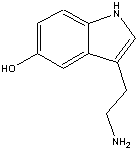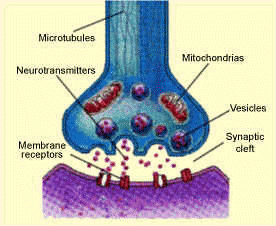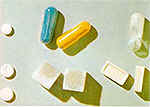Serotonin was first recognised as a powerful vasoconstrictor in blood serum. It was isolated in 1948 by Page and was later found to be associated with the central nervous system.
 The
chemical name for serotonin is 5-hydoxytryptamine which is often abbreviated to
5-HT.
The
chemical name for serotonin is 5-hydoxytryptamine which is often abbreviated to
5-HT.
Serotonin is naturally produced in the Pineal gland which lies deep at the centre of the human brain. The average adult human possesses only 5 to 10 mg of serotonin, 90 % of which is in the intestine and the rest in blood platelets and the brain.
One role of this 'wonder drug' is as a neurotransmitter, allowing numerous functions in the human body including the control of appetite, sleep, memory and learning, temperature regulation, mood, behaviour, cardiovascular function, muscle contraction, endocrine regulation and depression. Subsequent to his discovery of Serotonin, Page commented that no physiological substance known possesses such diverse actions in the body as does serotonin.
5-HT is also found in wasp stings and scorpion venom where its function is of an irritant, since intravenous injection of serotonin in humans leads to pain, gasping, coughing, a tingling and prickling sensation, nausea, cramps and other unpleasant symptoms.
Synthesis of Serotonin
Serotonin is manufactured in the human brain using the essential amino acid tryptophan which is found in foods such as bananas, pineapples, plums, turkey and milk.
The enzyme tryptophan hydroxylase adds a hydroxyl group to tryptophan's benzene ring at position 5, creating 5-hydroxytryptophan. Another enzyme, amino acid decarboxylase, then removes a carboxyl group from 5-hydroxytryptophan, forming 5-hydroxytryptamine which is more commonly known as serotonin.

Serotonin as a neurotransmitter
Serotonin is a neurotransmitter involved in the transmission of nerve impulses. Neurotransmitters are chemical messengers within the brain that allow the communication between nerve cells.
Packets of serotonin (vesicles) are released from the end of the presynaptic cell
 into the synaptic cleft. The serotonin
molecules can then bind to receptor proteins within the postsynaptic cell, which
causes a change in the electrical state of the cell. This change in
electrical state can either excite the cell, passing along the chemical message,
or inhibit it. Excess serotonin molecules
are taken back up by the presynaptic cell and reprocessed.
into the synaptic cleft. The serotonin
molecules can then bind to receptor proteins within the postsynaptic cell, which
causes a change in the electrical state of the cell. This change in
electrical state can either excite the cell, passing along the chemical message,
or inhibit it. Excess serotonin molecules
are taken back up by the presynaptic cell and reprocessed.
The neurons in the brain that release serotonin are found in small dense collections of neurons called Raphe Nuclei. The Raphe Nuclei are found in the medulla, pons and midbrain which are all located at the top of the spinal cord. Serotonergic neurons have axons which project to many different parts of the brain, therefore serotonin affects many different behaviors.
Depression
Low serotonin levels are believed to be the cause of many cases of mild to
severe depression which can lead to symptoms such as anxiety, apathy, fear,
feelings of worthlessness, insomnia and fatigue. The most concrete
evidence for the connection between serotonin and depression is the decreased
concentrations of serotonin metabolites in the cerebrospinal fluid and brain
tissues of depressed people.
worthlessness, insomnia and fatigue. The most concrete
evidence for the connection between serotonin and depression is the decreased
concentrations of serotonin metabolites in the cerebrospinal fluid and brain
tissues of depressed people.
If depression arises as a result of a serotonin deficiency then pharmaceutical agents that increase the amount of serotonin in the brain should be helpful in treating depressed patients. Anti-depressant medications increase serotonin levels at the synapse by blocking the reuptake of serotonin into the presynaptic cell. Anti-depressants are one of the most highly prescribed medications despite the serious side-effects they can cause.
If depression is mild enough it can sometimes be managed without prescribed medications. The most effective way of raising serotonin levels is with vigorous exercise. Studies have shown that serotonin levels are increased with increased activity and the production of serotonin is increased for some days after the activity. This is the safest way of increasing serotonin levels and many other benefits result from regular exercise.
Serotonin levels can also be controlled through the diet. A diet deficient in omega-3 fatty acids may lower brain levels of serotonin and cause depression. Complex carbohydrates raise the level of tryptophan in the brain resulting in a calming effect. Vitamin C is also required for the conversion of tryptophan into serotonin.
Lysergic Acid Diethylamide
Lysergic acid diethylamide, more commonly known as LSD, is a non-toxic,
non-addictive molecule which mimics serotonin in the brain. The body
'mistakes' LSD for serotonin and
shoots it across the synaptic cleft. LSD has a higher affinity for 5-HT
receptors than serotonin, thus the presence of LSD prevents serotonin from sending neural messages in the brain. Once the LSD molecule
is bound to the receptor proteins the message is not carried any further.
Instead the impulse is redirected to the older parts of the brain, where the
bloodstream then takes it to the sense interpretive centres and the motor areas.
serotonin from sending neural messages in the brain. Once the LSD molecule
is bound to the receptor proteins the message is not carried any further.
Instead the impulse is redirected to the older parts of the brain, where the
bloodstream then takes it to the sense interpretive centres and the motor areas.
http://faculty.washington.edu/chudler/lsd.html
There are many similarities between the molecules of serotonin and LSD which allows this process to occur, the most obvious being their close structural similarities, particularly the indole ring shown highlighted in blue.
![]() Back to Molecule of the Month page [DOI:10.6084/m9.figshare.5436913]
Back to Molecule of the Month page [DOI:10.6084/m9.figshare.5436913]